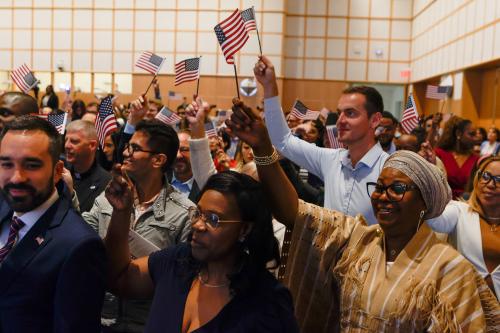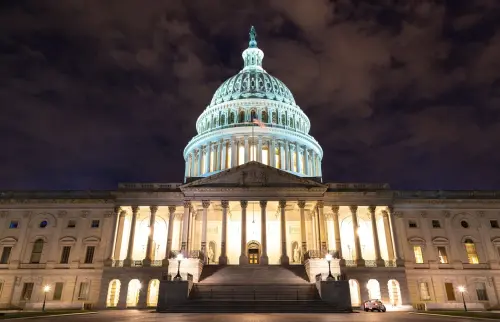Immigration took center stage during the 2024 election cycle, with 76% of Republicans describing it as a top priority for the president to address this year. Trump is outspoken on the subject, and immigration policy is likely to undergo major changes with the presidential transition. But the exact contours will depend on the strength of several competing interests. Below, we discuss three possible scenarios, ranging from the biggest to smallest departure from the status quo.
First, a little background on some key issues to watch:
Mass deportation
On the campaign trail, Trump promised the largest deportation effort in American history. Trump’s first term increased deportations from the interior relative to Obama’s second term (see Figure 1), but did not come close to realizing the levels of Obama’s first term or implementing what most would consider mass deportation. Interior enforcement was, however, less targeted than under Obama and created widespread fear.
This time around, there will likely be some high-profile enforcement events designed to send a signal early in the administration. Whether Trump goes further to enact large-scale deportation efforts remain to be seen. The logistical, staffing, and resource challenges are significant, and to move in this direction the administration would need to enlist the assistance of the National Guard, local law enforcement, or other entities not usually involved in immigration enforcement. To significantly ramp up the scale of the effort, the administration would also need to pursue arrests on the street and in sensitive locations like schools, churches, and hospitals. It is easy to imagine backlash of the sort that emerged with Trump’s family separation policy in 2018.
One group at particular risk is the four to five million who have come to the U.S. in the last few years with a temporary parole or a notice to appear in immigration court. Many are pursuing an asylum claim, and if history is a guide more than half will not be granted asylum status. Trump is likely to take a hard line with those denied asylum, though again logistical hurdles are likely to constrain what the administration can do to some degree.
Ultimately, the Trump administration is unlikely to enact mass deportation on the scale which it has suggested on the campaign trail. The rhetoric is damaging in and of itself, however, because it discourages immigrants from showing up at work, sending their kids to school, and seeking health care. And interior enforcement will be much more aggressive than what we have seen in recent years, particularly at the beginning of the administration.
Border Flows
The new administration is likely to put significant resources towards border enforcement and restricting border flows of asylum-seekers. Though the U.S. is bound by international treaty to consider asylum claims, this obligation was partially circumvented from 2020 to 2023 using the Title 42 public health authority. There were, however, large numbers of people who were permitted to enter the United States in 2022 through early 2024 because they were granted a parole or notice to appear in immigration court (see Figure 2). In summer 2024, Biden issued an emergency order limiting asylum consideration for those who enter between ports of entry, resulting in sharply reduced flows.
The new administration will continue to make it more difficult for migrants to seek asylum and, for those that are able to proceed with their case, to wait in the U.S. while doing so. In January 2019, Trump and Mexican President Andrés Manuel López Obrador enacted the Migrant Protection Protocols (MPP), commonly called the “Remain in Mexico” program. 71,000 asylum seekers—including children and those with disabilities and chronic illnesses—were sent to Mexico under the two years of the original program, generating significant humanitarian concerns relating to inadequate shelter and safety on the Mexican side of the border. Reinstatement of this policy will take cooperation with Mexico and judicial support, but it is likely the administration will pursue this or similar policies to reduce the flow of asylum-seekers.
Humanitarian Protections
Several large humanitarian parole programs will likely be terminated in the new administration. The Biden-era programs for Cubans, Haitians, Nicaraguans, Venezuelans (CHNV), and Ukrainians (U4U) are likely to immediately stop processing new applications. These two programs have welcomed 500,000 parolees as of December 2023. Parolees typically have two years of protection; recipients will be at risk of deportation if they have not secured asylum or another adjustment of status before their two years are up. The administration could choose to go further and try to revoke the existing status of those living in the U.S. under these humanitarian programs.
Another long-standing humanitarian parole program is Temporary Protected Status (TPS), which has permitted protection from deportation and work authorization to migrants from countries whose unstable conditions—such as environmental disasters and armed conflicts—prevent their safe return temporarily. More than 850,000 individuals live in the United States under TPS. Under proposed mandates from Project 2025, TPS designations would be repealed, causing individuals from some or all TPS-designated countries to lose their work permit and protection from deportation overnight.
The Trump administration is expected to continue its opposition to DACA or Deferred Action for Childhood Arrivals, a program providing protection for immigrants who arrived in the U.S. as children. The Supreme Court prevented the administration from dismantling the program in 2020 on technical grounds, but the legal effort may well succeed in the new term. There are 535,000 or so “dreamers” who are likely to be impacted.
Legal Pathways
The administration will add sand to the gears of existing legal migration pathways without needing Congress to act. One mechanism proposed by Project 2025 is a cutoff for visa applications that are deemed excessively backlogged, and student visas from China could be substantially limited. A reinstatement of the “Muslim ban” on travel from certain countries is not unlikely. Given the backlogs in many parts of the system, simply slow-walking the routine work of immigration processing could reduce employment-based and family-based immigration, as occurred during the first Trump administration (see Figure 3).
The reduction in legal migration pathways is unfortunate given that the system already restricts regular migration at levels that many consider too low, with annual caps on legal migration that have been largely stagnant since 1990.
Other policy areas to watch
Immigration policy is traditionally a federal matter. The degree to which states and localities can pursue immigration enforcement or take actions to protect immigrants from enforcement or otherwise support undocumented migrants is contested. For example, the administration is likely to put pressure on so-called “sanctuary cities” that limit cooperation with federal enforcement efforts. The same is true for the 26 states and D.C. that offer in-state tuition to DACA recipients and other undocumented immigrants. At the same time, the administration will encourage efforts of local law enforcement to facilitate immigration enforcement.
The administration may also look for ways to hamper immigrant integration. Something like the 2018 “public charge” rule proposal may deter immigrants from accessing the U.S. safety net. (Undocumented immigrants are already ineligible for most programs.) Resources for communities welcoming new arrivals in schools and shelters are likely to be curtailed. (We have argued elsewhere that the federal government should support localities bearing the short-term costs of new immigrants.)
So what will come to pass in 2025? Here are three possible scenarios:
1. More bark than bite
The administration will almost certainly make visible anti-immigration efforts in the first 100 days. This would likely include some high-profile deportation raids, immediately ending the Biden administration’s humanitarian parole programs, and restrictions on travel or student visas from certain countries. But the first Trump administration had comparatively modest deportation rates overall, and the same could be true again if the interests of the business community prevail. The main effect of the early efforts in this scenario would be to create fear and uncertainty in immigrant communities and to hamper the immigration bureaucracy as was done in the first administration. The result would be a slowing of immigration that, while meaningful, would not be much different than what was seen in Trump’s first term.
2. Aggressive anti-immigrant policy, within the bounds of the law
The executive branch has considerable latitude over immigration policy, especially given the apparent unwillingness of Congress to legislate on the issue. Project 2025 has devoted substantial attention to policy development on the issue, which could serve as a blueprint for the new administration. Proposed measures include limiting and slowing current legal immigration avenues, further restricting border flows with harsh tactics, eliminating humanitarian protections, and significantly ramping up deportation efforts. In this scenario, we have projected net negative migration, with repercussions for the macroeconomy as well as significant localized disruptions to particular industries like agriculture, construction, hospitality, and direct care. This scenario would also involve widespread trauma in immigrant communities, including for the estimated 4.4 million U.S. citizen children with an undocumented parent.
3. Constitutional crisis
The administration could choose to make immigration policy a testing ground for the limits of executive power. In the first administration, there were court decisions constraining the administration. For example, the Supreme Court ruled against the termination of the Deferred Action for Childhood Arrivals program and the courts curtailed the so-called “Muslim ban” that limited visas from certain countries. Faced with court challenges, there is a small chance that the new administration could choose to disregard court orders, thereby precipitating a constitutional crisis.
Whichever scenario comes to pass, there is no doubt that the new administration will change both rhetoric and reality of America’s immigration system. The exact contours will depend in part on the political and legal battles that ensue. But, almost certainly, immigration flows will slow and enforcement will become much harsher, both with significant consequences for the economy and beyond.
-
Acknowledgements and disclosures
The Brookings Institution is financed through the support of a diverse array of foundations, corporations, governments, individuals, as well as an endowment. A list of donors can be found in our annual reports, published online. The findings, interpretations, and conclusions in this report are solely those of its author(s) and are not influenced by any donation.
The Brookings Institution is committed to quality, independence, and impact.
We are supported by a diverse array of funders. In line with our values and policies, each Brookings publication represents the sole views of its author(s).








Commentary
What to expect on immigration policy from a Trump White House
Five policy areas and three scenarios
December 19, 2024